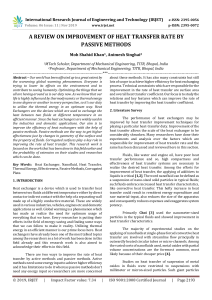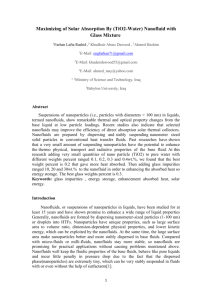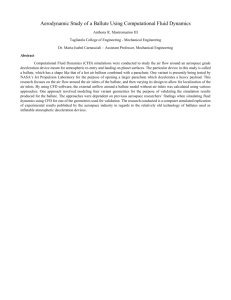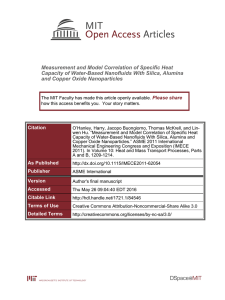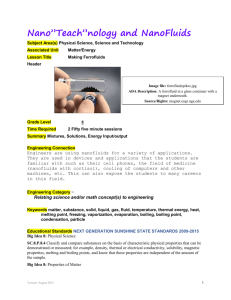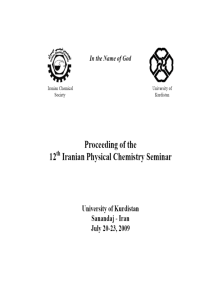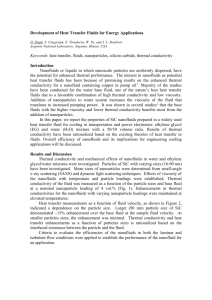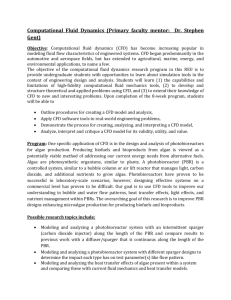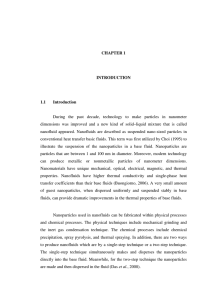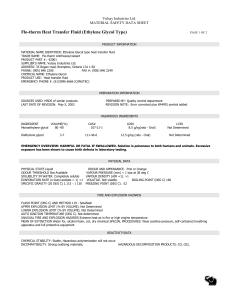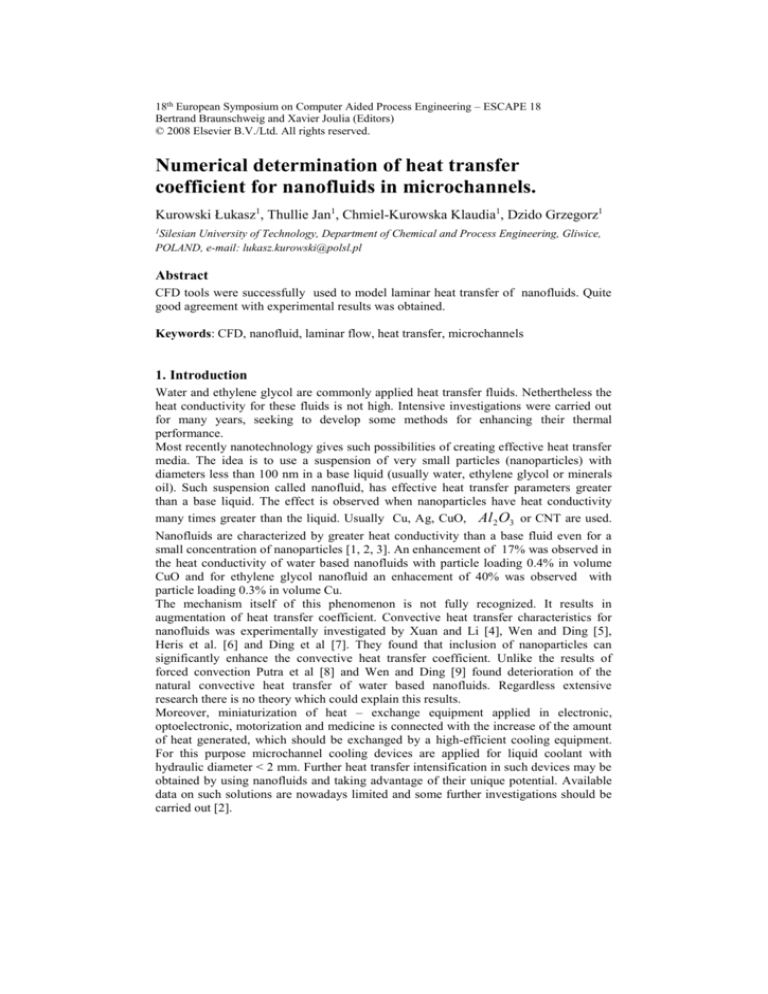
18th European Symposium on Computer Aided Process Engineering – ESCAPE 18
Bertrand Braunschweig and Xavier Joulia (Editors)
© 2008 Elsevier B.V./Ltd. All rights reserved.
Numerical determination of heat transfer
coefficient for nanofluids in microchannels.
Kurowski Łukasz1, Thullie Jan1, Chmiel-Kurowska Klaudia1, Dzido Grzegorz1
1Silesian
University of Technology, Department of Chemical and Process Engineering, Gliwice,
POLAND, e-mail: lukasz.kurowski@polsl.pl
Abstract
CFD tools were successfully used to model laminar heat transfer of nanofluids. Quite
good agreement with experimental results was obtained.
Keywords: CFD, nanofluid, laminar flow, heat transfer, microchannels
1. Introduction
Water and ethylene glycol are commonly applied heat transfer fluids. Nethertheless the
heat conductivity for these fluids is not high. Intensive investigations were carried out
for many years, seeking to develop some methods for enhancing their thermal
performance.
Most recently nanotechnology gives such possibilities of creating effective heat transfer
media. The idea is to use a suspension of very small particles (nanoparticles) with
diameters less than 100 nm in a base liquid (usually water, ethylene glycol or minerals
oil). Such suspension called nanofluid, has effective heat transfer parameters greater
than a base liquid. The effect is observed when nanoparticles have heat conductivity
many times greater than the liquid. Usually Cu, Ag, CuO, Al 2 O3 or CNT are used.
Nanofluids are characterized by greater heat conductivity than a base fluid even for a
small concentration of nanoparticles [1, 2, 3]. An enhancement of 17% was observed in
the heat conductivity of water based nanofluids with particle loading 0.4% in volume
CuO and for ethylene glycol nanofluid an enhacement of 40% was observed with
particle loading 0.3% in volume Cu.
The mechanism itself of this phenomenon is not fully recognized. It results in
augmentation of heat transfer coefficient. Convective heat transfer characteristics for
nanofluids was experimentally investigated by Xuan and Li [4], Wen and Ding [5],
Heris et al. [6] and Ding et al [7]. They found that inclusion of nanoparticles can
significantly enhance the convective heat transfer coefficient. Unlike the results of
forced convection Putra et al [8] and Wen and Ding [9] found deterioration of the
natural convective heat transfer of water based nanofluids. Regardless extensive
research there is no theory which could explain this results.
Moreover, miniaturization of heat – exchange equipment applied in electronic,
optoelectronic, motorization and medicine is connected with the increase of the amount
of heat generated, which should be exchanged by a high-efficient cooling equipment.
For this purpose microchannel cooling devices are applied for liquid coolant with
hydraulic diameter < 2 mm. Further heat transfer intensification in such devices may be
obtained by using nanofluids and taking advantage of their unique potential. Available
data on such solutions are nowadays limited and some further investigations should be
carried out [2].
Ł. Kurowski et al.
2
2. Mathematical models and numerical method
The purpose of the work is modeling of an experimental plant used for investigation of
nanofluids laminar flow convective heat transfer. The plant consists of a cooper tube
1.4 mm inner diameter and 620 mm length (Fig 1). The tube is heated up by an electric
heater generating heat flux q = 2000 – 30 000 W/m2. Ethylene glycol is used as base
fluid and Cu as nanoparticles (100 nm). Because of small concentration of nanoparticles
(0.15% particle volume fraction) the pseudohomogeneous model was applied, so
nanofluid is treated more like fluid rather than liquid-solid mixture. Similar approach
was presented by Maiga and Palm [10].
Ltot
Lh
dQ=0
r
Q
dQ=0
z
fluid flow
inlet
outlet
z=0
z = Ltot
r = Ri
r = R0
Fig. 1 Experimental system
The continuity, momentum and energy equations written in vector form are
. v = 0
( v.
(1)
) ρv = - P + . (η v)
c p v. T =
k T
2
(2)
(3a)
For the tube wall the energy equation is
k s 2Ts = 0
(3b)
The boundary conditions are
z 0 , 0 r Ri , u u 0 , T T0
0 z Ltot , r 0 ,
T
u
0, s 0, v 0
r
r
r Ri , u v 0
The conditions for heated wall are
(4a)
(4b)
(4c)
Numerical determination of heat transfer coefficient for nanofluids in microchannels
r R0 , q 0 k s
Ts
r
3
(5a)
for heated part of the tube
ks
Ts
0
r
(5b)
for nonheated part of the tube
z Ltot , 0 r R0 ,
T s
0
z
(5c)
The set of equations (1)-(3) together with boundary conditions (4-5) was solved by
numerical method based on finite volume approach. The equations were solved in 2D
with commercial CFD code FLUENT 6.3. In order to ensure that the solution does not
depend on the number of grid points several different types of grids were tested. After
preliminary calculations a non uniform grid 55 x 1296 was chosen. Finer grid point
spacing was used at the entrance and exit region. Two wall heat fluxes were simulated,
namely 14 331 and 19 108 W/m2. Supplied heat flux was not uniform along the tube.
Appropriate measurements gave functional relationship used in boundary conditions.
The results were compared with experimental data.
3. Thermophysical properties of nanofluids and heat transfer coefficient
We assume that the nanoparticles are well dispersed within the base-fluid, so the
effective physical properties are described by classical formulas:
ρnf 1 Φ ρl Φρ p
(6)
cnf 1 Φ Cl Φ c p
(7)
however temperature dependence of l, p, cl and cp was taken into account.
The dynamic viscosity of nanofluids was determined from functional relationship
obtained by performing a least-square curve fitting of experimental data. The
measurements were done by Brookfield DV-II+ Pro apparatus and plotted in Fig. 2 as
temperature function. It shows that the temperature dependence of nanofluid viscosity
as well as pure ethylene glycol viscosity is very strong. It is worth nothing that
nanofluid viscosity at 318K is three times greater than ethylene glycol viscosity at the
same temperature.
The Maxwell correlation was used for determination of nanofluid effective thermal
conductivity as follows
k nf
k p 2k l 2(k p k l )Φ
k p 2k l (k p k l )Φ
kl
(8)
Ł. Kurowski et al.
4
0.08
nanofluid
nanofluid - experimental data
EG
EG - experimental data
0.06
[Pas] 0.04
0.02
0
280
300
320
340
360
T [K]
Fig 2. Nanofluid effective viscosity compared to viscosity of pure base fluid
Local Nu numbers and heat transfer coefficients were calculated according to equations
hd i
k
(9)
q
Twx Tbx
(10)
Nu
h
Where q is the heat flux, Twx and Tbx are respectively, the wall and fluid bulk
temperatures, d is tube diameter and k is the fluid thermal conductivity.
The fluid bulk temperatures at x position were calculated according to the following
equation:
Tbx Tin
PqLx
mcp
(11)
where P is a perimeter of the test tube.
4. Results and conclusions
CFD tools made important contributions to process modeling [11, 12] This work
presents some capabilities of CFD technology to improve modeling of an experimental
plant. Discrepancy between measured and calculated temperature profiles gives rise to
careful reassessment of the wall boundary conditions and formulation of functional
relationship for the heat flux supplied by the heater which gives dependence on the axial
coordinate.
Numerical determination of heat transfer coefficient for nanofluids in microchannels
360
360
2.7 l/h - CFD
2.7 l/h - exp.
5.2 l/h - CFD
5.2 l/h - exp.
6.7 l/h - CFD
6.7 l/h - exp.
350
2.7 l/h - cfd
2.7 l/h - exp.
4.0 l/h - cfd
4.0 l/h - exp.
5.3 l/h - cfd
5.3 l/h - exp.
6.7 l/h - cfd
6.7 l/h - exp.
350
340
5
340
T [K]
T [K]
330
330
320
320
310
310
0
a)
0.2
0.4
0.6
0.8
1
x/L
0
0.2
b)
0.4
0.6
0.8
1
x/L
Fig. 3 Axial temperature profiles in the tube wall cooled by: a) pure EG, b) nanofluid: EG + Cu
Calculations were performed for ethylene glycol (100%) and nanofluid Cu/ethylene
glycol for different Re numbers in laminar flow. The inlet fluid temperature was kept
constant at 318 K.
Wall temperature profiles were presented in Figs 3a and 3b. The curve parameter was
mass flow rate of nanofluid and a fit with experimental points is good. Fig. 4 compares
the wall temperature with uniform heat supply to experimental conditions. At the
entrance to the tube the difference between profiles is quite noticeable. It is caused by
the heater construction. Fig. 5 shows the mean heat transfer coefficient as a function of
Re number.
350
q: f(x), prop.: f(T)
q: const, prop.: f(T)
experimental data
340
T [K] 330
320
310
0
0.2
0.4
0.6
0.8
1
x/L
Fig. 4. Axial temperature profiles in the tube wall for uniform heated tube – simulated and for
experimental conditions.
Quite good agreement with experiments were obtained, however the scatter of
experimental results suggests that the problem is still open.
Ł. Kurowski et al.
6
4000
3500
3000
have [W/m2K]
2500
CFD - EG
CFD - nanofluid: EG + Cu
exp. data - EG
exp. data - nanofluid: EG + Cu
2000
1500
0
40
80
120
160
200
240
Re
Fig.5 Dependence of average heat transfer coefficient vs. Re number
References
[1] V.Trsaksri, S. Wongwises; Renewable and Sustainable Energy Reviews, 11, (2007), 512
[2] W. Daungthongsuk, S. Wongwises; Renewable and Sustainable Energy Reviews,
11, (2007), 797
[3] X-Q Wang, A.S. Mujumdar; International Journal of Thermal Sciences, 46, (2007), 1
[4] Y. Xuan and Q. Li; Journal of Heat Transfer 125, (2003), 151
[5] D. Wen, Y. Ding; International Journal of Heat and Mass Transfer, 47, (2004), 5181
[6] S. Heris, S.G. Etemad, M. Esfahany; International Communications in Heat and Mass
Transfer, 33, (2006), 529
[7] Y. Ding, H. Alias, D. Wen, R.A. Williams; International Journal of Heat and Mass Transfer,
49, (2005), 240
[8] N. Putra, W. Roetzel, S.K. Das; Heat and Mass Transfer 39, (2003) 775
[9] D. Wen, Y. Ding; International Journal of Heat and Fluid Flow, 26, (2005), 855
[10] S.E.B. Maiga, S.J. Palm, Internationa Journal of Heat and Fluid Flow 26, (2005), 530
[11] C,C, Pantelides, Computer Aided Process Engineering, 9, 2001, 15 (ESCAPE 11)
[12] F. Bezzo, S. Macchietto, C.C. Pantelides, Computers and Chemical Engineering,
24, (2000), 653.
Nomenclature
cp – specific heat capacity, J/kgK
Ri – inner radius, m
h – heat transfer coefficient,
Ro – outer radius, m
W/m2K
k – thermal conductivity of fluid W/mK
T – fluid temperature, K
ks – thermal conductivity of solid W/mK
Ts – wall temperature, K
Ltot –total length of the channel, m
u, v – velocity components, m/s
Lh –heating length of the channel, m
z – axial coordinate, m
q –heat flux,
viscosity, Pa s
W/m2
r –radial coordinate, m
-density, kg/m3

